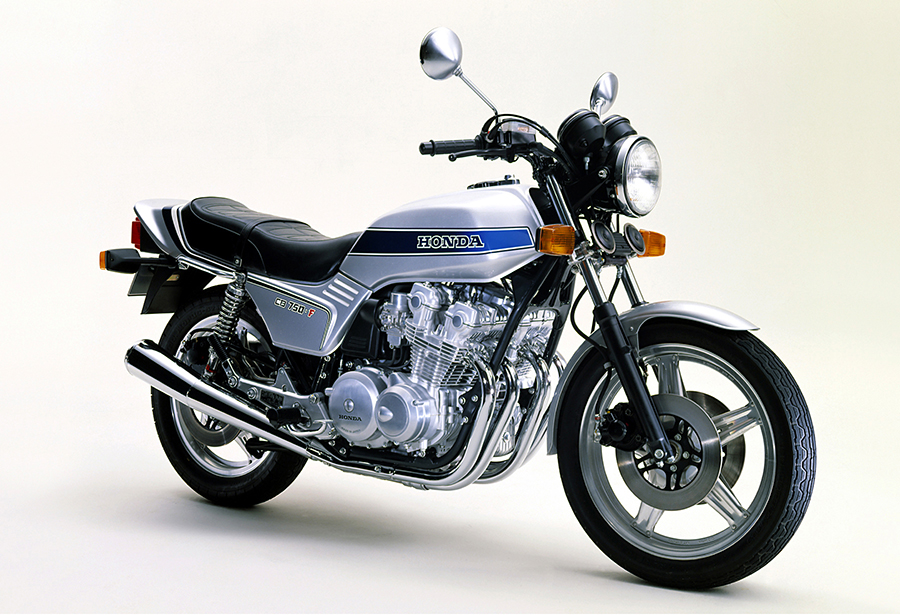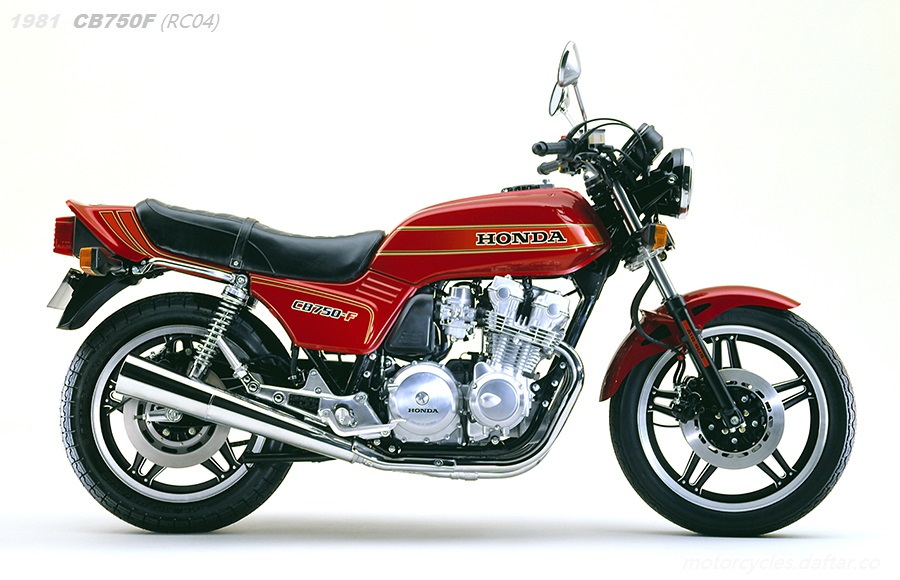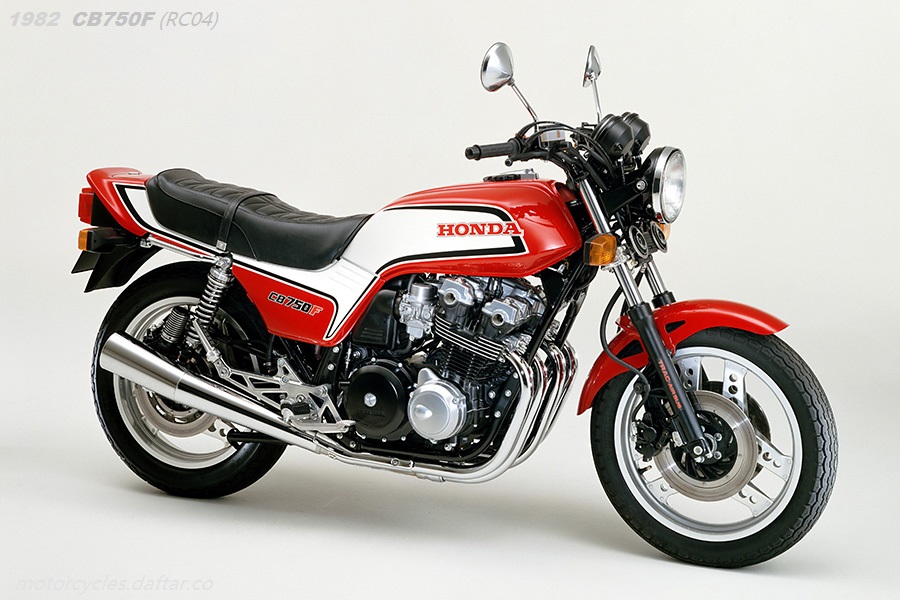1979 Honda CB750F (RC04) Super Sports DOHC Photos Gallery, Specs & Overview.
 |
| 1979 Honda CB750F picture. A real sports model equipped with a DOHC (double overhead camshaft) 4-valve (2 intake, 2 exhaust) engine, innovative body design and excellent maneuverability, is released. |
On June 23, 1979, the Honda CB750F, a sports bike equipped with a DOHC, 4-cylinder, 16-valve engine with a maximum output of 68 horsepower and an innovative and dynamic body design, will go on sale. The Honda CB750F was the core model of the CB Nanahan, which inherited the lineage of the Dream CB750 Four (1969-). The model name is RC04. It was a “sports model dedicated to running” (from a press release at the time) equipped with an air-cooled 4-stroke in-line 4-cylinder DOHC 4-valve engine (68ps) with a displacement of 748cc on a double cradle frame. For that reason, we adopted a 4into2 collective muffler, a low separate handle, a triple disc brake (front double disc), an FVQ damper (rear) with a variable damping force adjustment mechanism, etc., and combined aluminum Comstar wheels with tubeless tires. It had been. It evolved while receiving minor changes, and in 1982, the CB750F Integra appeared as a derivative model. The export model of the CB750F is the CB900F. At that time, the maximum displacement of motorcycles officially sold in Japan was 750cc (this regulation was abolished in 1990).
This Honda CB750F was developed as a sports model dedicated to running. It is a two-wheeled vehicle with light driving performance that adopts powerful 4into2 group muffler, low and short separate steering wheel, triple (3) disc brakes, Honda’s unique variable FVQ damper, etc. (Compliant with 1954 noise regulations)
Main Features
Engine
- 4-valve = A pent-roof type combustion chamber with excellent combustion efficiency was adopted, and high intake and exhaust efficiency was also aimed for, with a total of 4 valves per cylinder, 2 intake valves and 2 exhaust valves, for a total of 16 valves in 4 cylinders. It is an engine with a precise mechanism.
- DOHC = (double overhead camshaft). Accurate intake and exhaust timing is possible by incorporating two camshafts, one on the intake side and one on the exhaust side, for opening and closing the intake and exhaust valves.
- Transistor ignition: By adopting a non-contact type transistor ignition device, reliable ignition and startability can be improved, and inspection and maintenance are excellent.
- 4into2 muffler = In order to improve horsepower and torque in the low and medium speed range, the exhaust system has four exhaust pipes gathered into two silencers.
Motorcycle body
- Frame: Lightweight and highly rigid double cradle type, with highly durable tapered roller bearings in the handle bearings.
- 3 (triple) disc brakes = Equipped with front double and rear single disc brakes that demonstrate stable braking power to control high dynamic performance.
- Suspension: Honda’s unique FVQ damper with damping force adjustment mechanism is used in the rear to allow optimal adjustment according to road conditions, load, speed, etc.
- Tires = Tubeless tires are used for both the front and rear wheels to improve safety. The wheels are lightweight and supple all-aluminum Comstar wheels.
- Handle, Meter = A separate handle made of forged duralumin enables light maneuverability. In addition, the meter is large and has excellent visibility.
- Design = Honda’s original fresh and dynamic streamline emphasizes sportiness.
1979 Honda CB750F Price
Standard cash price at time release was 538,000 yen. (Excluding Hokkaido and some remote islands)
Honda’s 750 series consists of three models: this “Honda CB750F“, the neat and dignified Honda CB750K, and the Honda Aira which adopted the first automatic (Hondamatic) mechanism in a two-wheeled vehicle. It has become something that can meet a wide range of users according to its enhancement and usability. Annual production of 15,000 units (including exports) is planned.
1979 Honda CB750F Specifications
Main specs of Honda CB750F (RC04) model year 1979:
| Motorcycle name | Honda CB750F | |
| Model | Honda RC04 | |
| Total length (m) | 2.190 | |
| Width (m) | 0.795 | |
| Height (m) | 1.125 | |
| Length (m) | 1.515 | |
| Vehicle weight (kg) | Maintenance:247, Drying:228 | |
| Minimum turning radius (m) | 2.6 | |
| Fuel tank capacity (L) | 20 | |
| Fuel consumption rate (km/L) (60km/h level running test value) | 32 | |
| Slope climbing ability (tanθ) | 0.46 | |
| Engine type | Air-cooled 4-cycle DOHC 4-cylinder 16-valve | |
| Total Displacement (cm3 ) | 748 | |
| Inner Diameter x Stroke (mm) | 62.0×62.0 | |
| Compression Ratio | 9.0 | |
| Max Power (PS/rpm) | 68/9,000 | |
| Max torque (kg-m/rpm) | 5.9/8,000 | |
| Starting method | Self-operated | |
| Lubrication method | Combination of pressure feed type and splash type | |
| Lubricant capacity (L) | 4.5 | |
| Primary reduction ratio | 2.381 | |
| Transmission ratio | 1st | 2.533 |
| 2 speed | 1.789 | |
| 3 speed | 1.391 | |
| 4 speed | 1.160 | |
| 5 speed | 0.964 | |
| Final gear ratio | 2.388 | |
| Frame format | Double cradle format | |
| Suspension (front) | Telescopic | |
| Suspension type (rear) | Swing arm type | |
| Caster (degrees) | 27°30′ | |
| Trail (mm) | 117 | |
| Tire Size | (Front) | 3.25H19-4PR Tubeless |
| (Rear) | 4.00H18-4PR tubeless | |
| Brake type | (Front) | Hydraulic double disc |
| (Rear) | hydraulic single disc | |
Honda CB750F Series
1981 Model Honda CB750-F
 |
| 1981 Honda CB750F |
This “Honda CB750F model year 1981” has further improved fuel economy and ease of use in the medium and low speed range, and at the same time, achieves the largest output of domestic motorcycles at 70 horsepower. In addition, the use of a comfortable front air suspension and Honda’s unique dual-piston caliper brakes that further improve braking performance can demonstrate excellent steering stability. In addition, the use of lightweight all-a black comstar wheels made of Lumi and duralumin forged parts emphasizes the “dauntlessness” and “high quality feel” suitable for a 750cc super sports bike.
Equipped with a DOHC, 4-cylinder, 16-valve engine with a total displacement of 748 cm3, maximum output of 70 PS (68 PS for custom) / 9000 rpm, maximum torque of 6.0 kg-m / 7500 rpm (7000 rpm for custom).
Increased torque in the low to medium speed range, demonstrating smooth driving performance from low to medium to high speeds, and improved fuel efficiency from 32km/L to 35km/L (60km/h level driving test value)
1982 Model Honda CB 750F
 |
| 1982 Honda CB750F It has been released with improved ride comfort and handling performance. |
The Honda CB750F model year 1982, a large two-wheeled sports bike equipped with an air-cooled 4-cycle DOHC parallel 4-cylinder 16-valve engine, is released on June 10 1982 with further improved ride comfort and handling performance. This new Honda CB750F further enhances the quality of driving as a large sports car that demonstrates excellent handling stability and comfortable ride from urban driving to long touring.
The main improvements this time are:
- Equipped with Honda’s unique torque response anti-dive mechanism (TRAC mechanism) that suppresses sudden changes in posture during braking.
- Uses a large diameter front fork (39φ) that further improves steering stability.
- Equipped with dual piston caliper disc brakes with semi-metal pads for improved fade resistance and weather resistance.
- Equipped with a rear cushion with a reservoir tank that exhibits stable damping characteristics even during high-speed continuous driving.
- Uses 18-inch front wheels. At the same time, a flat wide tire is installed.